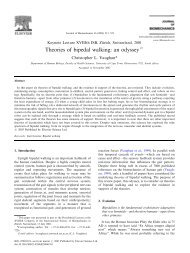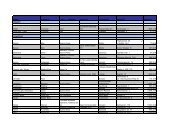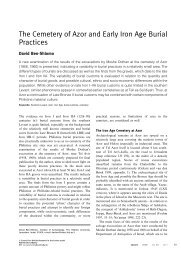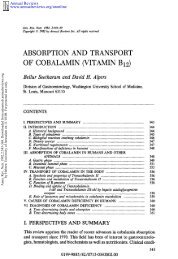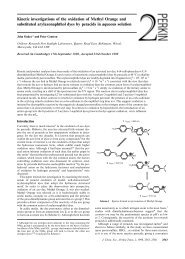The Riddle of Ramat Raḥel: The Archaeology of a Royal Persian ...
The Riddle of Ramat Raḥel: The Archaeology of a Royal Persian ...
The Riddle of Ramat Raḥel: The Archaeology of a Royal Persian ...
Create successful ePaper yourself
Turn your PDF publications into a flip-book with our unique Google optimized e-Paper software.
13that forms its inner wall, up to the point where the wall meets the northern cliff rock <strong>of</strong> the IronAge tower fortress. Here the channel veers from the building and turns sharply eastwards along thenorthern cliff face <strong>of</strong> the complex towards a destination that has yet to be determined. At theturning point eastward, the channel is joined from the west by a covered water channel (“tunnel”),ca. 4.5 m long. <strong>The</strong> origin <strong>of</strong> this "tunnel" from inside the building is not yet clear.As stated above, the building was dismantled to it foundations and very little <strong>of</strong> it hassurvived. Thus far, only a section <strong>of</strong> the floor close to the northeast corner has been uncovered.This floor is unique in its construction; it is built on a thick coating <strong>of</strong> up to 15 cm <strong>of</strong> grey cementover an infrastructure <strong>of</strong> thick-cut nari slabs. In addition, a wall has been exposed that divides theinner space <strong>of</strong> the building. It is 4 m long with a north-south trajectory and was constructed in asimilar "half casting" technique.<strong>The</strong> <strong>Persian</strong> Period Garden – Its Flora and Function<strong>The</strong> excavations at the site exposed the layout and installations <strong>of</strong> a magnificent garden, buioltalready as part <strong>of</strong> building level II, dated to the last third <strong>of</strong> the 7th century BCE. <strong>The</strong> function <strong>of</strong>the garden, however, remained a mystery as there was no knowledge <strong>of</strong> the flora that had grownthere and the function it had served. Cutting-edge pollen research conducted at the site over thepast months has given us a window into the garden's past that was heret<strong>of</strong>ore unavailable (Langgutet al., forthcoming). Two plaster phases from pool number 2, located in the garden, were sampledfor pollen analysis. <strong>The</strong>se plaster layers are part <strong>of</strong> the later phases <strong>of</strong> the pool and the garden,probably dated to the <strong>Persian</strong> period, and they were not exposed to pollen from later periods sincethe pool went out <strong>of</strong> use in the Early Hellenistic period and was covered by a fill <strong>of</strong> slaked lime.<strong>The</strong> working hypothesis was that if the plaster on the walls <strong>of</strong> the pool was renewed when thegarden's plants were in bloom, the wet plaster's surface would trap pollen grains. <strong>The</strong>refore, theouter part <strong>of</strong> each <strong>of</strong> the two plaster phases was analyzed. <strong>The</strong> results were that, beside pollen <strong>of</strong>native Mediterranean maquis/forest taxa, the inner plaster phase also included pollen <strong>of</strong> fruit treesand ornamentals, which were certainly planted specifically for aesthetic and symbolic reasons.<strong>The</strong> most surprising fossil pollen find was the citron (Citrus medica, named etrog in Hebrew,a word with a <strong>Persian</strong> precursor), which is the earliest botanical evidence <strong>of</strong> this tree in thesouthern Levant; it apparently arrived from India via Persia (Zohary and Hopf 2000: 184). Otherimported trees identified in the pollen assemblages <strong>of</strong> <strong>Ramat</strong> <strong>Raḥel</strong> are <strong>Persian</strong> walnut (Juglansregia), cedar <strong>of</strong> Lebanon (Cedrus libani) and birch (Betula spp.). <strong>The</strong> Juglans regia originated in



